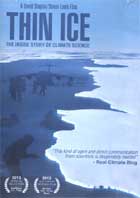
Thin Ice: The Inside Story of Climate Science 2013
Distributed by Green Planet Films, PO Box 247, Corte Madera, CA 94976-0247; 415-377-5471
Produced by Peter Barrett and Philip England
Directed by Simon Lamb and David Sington
DVD, color, 74 min.
General Adult
Technology, Polar Science, Climate Change, Environmental Education, Environmental Science
Date Entered: 08/25/2014
Reviewed by Andrew Jenks, California State University, Long BeachThis documentary on the science of polar ice and global warming is one of many recent films focusing on a particular threat to the global environment. In the last two years I have reviewed new films on sand, the Antarctic fisheries, aluminum, trash disposal, nuclear wastes, chemical dumps, river dams, hydraulic fracturing, and rising oceans. Each examines the problem of global pollution through the prism of a particular resource or industrial process. All of them, including this film, are powerful testimonials to the dangers of unchecked growth in the 20th and 21st centuries; and all of them separately and especially taken together provide little grounds for optimism about the ability of humans to forestall or reverse destructive practices that are fouling humanity’s collective nest.
The warnings repeated in all of these films are hardly new. The ecologist Garrett Hardin in 1968 coined the term “tragedy of the commons” to convey the perverse dynamic that was leading to irreversible environmental devastation and resource depletion. He suggested that in a culture where individuals, corporations and governments benefitted from the exploitation of common resources but were not forced to bear the true costs of that exploitation there was nothing to stop use of a resource in a “commons” until it was all used up. The Club of Rome, in its landmark 1972 report The Limits to Growth, similarly warned about the unsustainability of economic growth. Little seems to have been learned – though not for a lack of edifying and compelling attempts to educate the public.
In contrast to many other recent films on climate change, Thin Ice mostly focuses on the climate scientists investigating their subject, rather than on expanding the perspective to include the politicians, industries, and consumers responsible for various environmental problems. The filmmakers, consciously or not, seem to want to recapture the spirit of the heroic age of scientific exploration, when scientists inspired the younger generations and when their objectivity and authority was rarely challenged.
Focusing on the science itself is a surprisingly rare thing in films about climate science. Most films make a play for the viewer’s emotions and guilt, emphasizing narratives of unrestrained growth, irresponsible and selfish consumers, and venal politicians. Thin Ice eschews alarmist appeals in favor of a kind of revenge of the nerds – the scientists speaking for themselves and for their views on climate science. Those views have been under attack from powerful economic and political interests who frequently use the mass media to dismiss climate-change research as “junk science.” This film’s agenda is to let the scientists under attack dispel such views by showing themselves to be serious, informed, devoted, professional, smart, and only very rarely political.
Proving human responsibility for global warming is the core of the film. Climate scientists, as the film notes, have the ability to track nearly continuous human measurements of climate conditions in Antarctica for the last fifty years. They can also reach deep into the pre-human past by sampling ice and rock cores formed millions of years ago. The data clearly reveal a profound and lasting impact of human activity on global climate. Examination of ice-cores tells the story of cycles of warming and cooling over long periods of time – every 100,000 years or so. The higher the carbon dioxide levels, the higher the temperature; and the relationship between carbon dioxide increases and rising temperatures, scientists agree, is causal. Proof of a dramatic rising of carbon dioxide levels over the last three decades, due to human activities, thus promises a continuing and probably dramatic rise in global temperatures, which is already evident in meteorological data.
The film travels around the globe to interview scientists from various fields to unpack the scientific proof behind global warming. While its dispassionate and objective tone lends authority to the film’s claims, the film’s style does not make for exciting viewing. The complexity of climate science, and the need for sustained attention to understand the challenges of calculating temperature changes around the world, partly explains the strength of the movement against global science. Global-warming naysaying appeals to those who lack the patience to follow the explanations of experts. Many people, frankly, are far more receptive to the suggestion that complex explanations are really some sort of masking of a hidden agenda – a conspiracy to pull the wool over the eyes of the public and to get them to change habits that don’t need to be changed. Rather than being swayed by the scientific consensus, opponents of global warming cherry pick any piece of “science” (usually taken out of context) that might support their position. The film, like so many well-meaning documentaries on environmental science, therefore has the quality of preaching to the choir of already converted. Nonetheless, for those interested in the science rather than politics of global warming, this documentary provides an excellent introduction; and it might just inspire some younger viewers to embrace their inner nerd and pursue a career as a climate scientist.